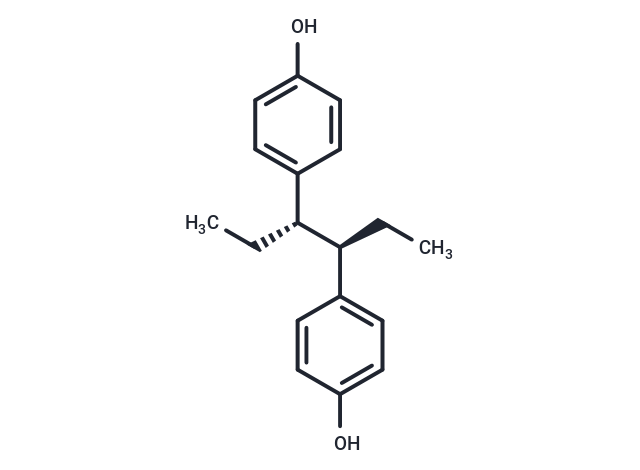Shopping Cart
- Remove All
 Your shopping cart is currently empty
Your shopping cart is currently empty

Hexestrol (Hexanoestrol) binds to ERα and ERβ with EC50 of 0.07 nM and 0.175 nM, respectively.

| Pack Size | Price | Availability | Quantity |
|---|---|---|---|
| 100 mg | 44 € | In Stock | |
| 200 mg | 64 € | In Stock | |
| 500 mg | 106 € | In Stock | |
| 1 mL x 10 mM (in DMSO) | 37 € | In Stock |
| Description | Hexestrol (Hexanoestrol) binds to ERα and ERβ with EC50 of 0.07 nM and 0.175 nM, respectively. |
| Targets&IC50 | ERβ:0.175 nM(EC50), ERα:0.07 nM(EC50) |
| In vitro | Hexestrol binds to ERα with EC50 of 0.07 nM and to ERβ with EC50 of 0.175 nM. [1] Hexestrol inhibits activity of AKR1B13 with IC50 of 3.2 μM. [2] Hexestrol inhibits the d-galactose dehydrogenase activity of thermophilus aldose 1-dehydrogenase with IC50 of 0.063 mM. [3] Hexestrol inhibits the dehydrogenase activity of AKR1C20 towards 10 μM 4-androsten-3α-o1-17-one with IC50 values of 2.7 μM. [4] Hexestrol inhibits 17HSD5 with IC50 of 30 μM, and inhibits TBER1 with IC50 of 0.8 μM. [5] Hexestrol reacts with DNA through the catechol quinone, thus can be a carcinogen. [6] |
| In vivo | Hexestrol administered intraperitoneally at dose of 6 mg/kg may decrease ovulation in mice, as evident by smaller ovaries and decreased luteal bodies and oocytes. [7] |
| Alias | meso-Hexestrol, Hexestrofen, Hexanoestrol |
| Molecular Weight | 270.37 |
| Formula | C18H22O2 |
| Cas No. | 84-16-2 |
| Smiles | [C@H]([C@H](CC)C1=CC=C(O)C=C1)(CC)C2=CC=C(O)C=C2 |
| Relative Density. | 1.093 g/cm3 |
| Storage | Powder: -20°C for 3 years | In solvent: -80°C for 1 year | Shipping with blue ice. | |||||||||||||||||||||||||||||||||||
| Solubility Information | H2O: < 1 mg/mL (insoluble or slightly soluble) DMSO: 50 mg/mL (184.93 mM), Sonication is recommended. Ethanol: 39 mg/mL (144.2 mM) | |||||||||||||||||||||||||||||||||||
Solution Preparation Table | ||||||||||||||||||||||||||||||||||||
Ethanol/DMSO
| ||||||||||||||||||||||||||||||||||||

Copyright © 2015-2024 TargetMol Chemicals Inc. All Rights Reserved.